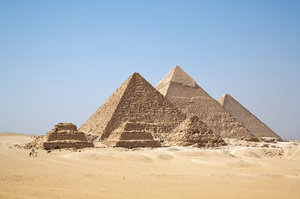|
The Great Pyramids of Giza
5,000 Years Ago, Egypt Kings Built Stairways to the Sky
by Rebekah Severson, age 15

The
plateau of Giza near Cairo, features the famous pyramids of Egypt. They are
considered the most extraordinary architecural structures in history. They also
depict the story of Egypt 5,000 years ago. These mysterious pyramids and their sheer size draw visitors from
around the world.
The
largest and oldest of the three main pyramids is the Great Pyramid of Khufu.
Khufu was the second king of the 4
th
dynasty. One of the most
remarkable burial vaults in history, this pyramid rivals the size of many other
world monuments.
This original pyramid rose to the height of 481.4
feet, which is 77 feet taller than the Salisbury Cathedral in England, and only
74 feet shorter than the Washington Monument. If a person stood at the base,
which is about 756 feet wide, the Khufu pyramid would block out the entire sky
with its immensity. The weight of this tomb is approximately six million tons,
and some of the blocks weigh 15 tons. Exemplifying the architecural talents of
ancient Egyptians, all four corners are accurately oriented to the four points
of a compass.
Although the Great Pyramid may dull the
magnificence of its two neighbors, the tombs of King Khafre and King Menkaure
add to the beauty of the Giza plateau.
Having been plundered and ransacked during ancient
and medieval times, the pyramids no longer hold the burial treasures they once
did. The outer layers of smooth white limestone have almost been completely
stripped away, diminishing their heights.
Although the pyramids may not be as tall as they
once were, or hold the riches of past pharaohs, the splendor of these
structures hasn’t decreased.
Egyptian kings believed they were “living gods” and built
themselves these extravagant tombs, or palaces. They wanted to prepare for
their journey after death, where they would join other gods. The pyramids were
strategically placed between the west bank of the Nile and the western horizon,
where the sun god Ra ended his journey across the sky each day.
These
palaces included public rooms and storage chambers, and were surrounded by
house-tombs. These were used by the courtiers, who would continue to serve the
king after they died. Also placed among these structures were subsidiary
pyramids, which were used as tombs for other members of the royal family.
The
great age of pyramid building, which lasted throughout the Old Kingdom (c.
2700-2200 BC), began with the Step Pyramid at Saqqara, built by King Zoser. The
Step Pyramid is believed to represent a staircase to the sky. The smooth-shaped
pyramids weren’t developed until later kings took the throne.
These
structures not onlydisplay the astounding architectural talents of ancient
Egyptians, but also tell the story of Egyptian history.
[Source:
Atlas of Mysterious Places; Encyclopedia Britannica
]
|

